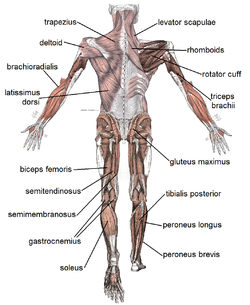Skeletal muscle
This relies largely or entirely on a single source. |
| Skeletal striated muscle/ Striated voluntary muscle | |
|---|---|
 Skeletal muscles, viewed from the front | |
 Skeletal muscles, viewed from the back | |
| Details | |
| Identifiers | |
| Latin | muscularis striatus skeletalis |
| MeSH | D018482 |
| TH | H2.00.05.2.00002 |
| Anatomical terminology | |
Skeletal muscle is a form of "striated" (striped) muscle tissue. It is under the voluntary control of the somatic nervous system (means you can control it with your conscious mind). Most skeletal muscles are attached to bones by bundles of collagen fibers that are known as tendons. It is one of three muscle types, the others being cardiac muscle and smooth muscle.
Skeletal muscle is made up of individual muscle cells or myocytes, known as muscle fibres. Muscle fibres do the work when muscles contract. A great deal is known about their structure and how they work. They contract when they get a nerve impulse.

Muscles provide strength, balance, posture, movement, and heat for the body to keep warm.[1]
Related pages[change | change source]
